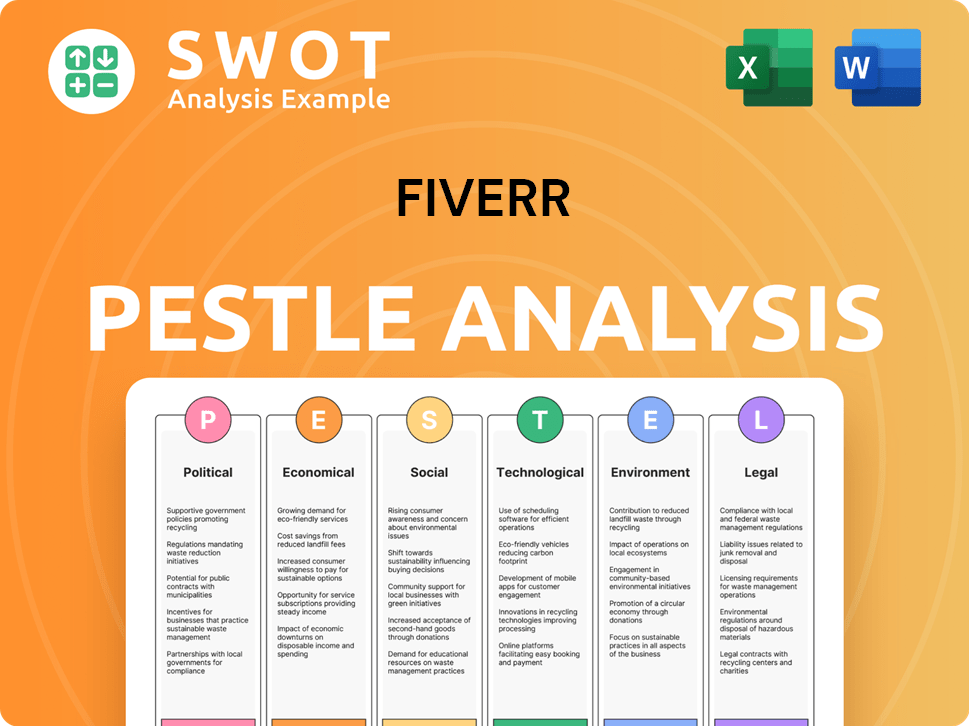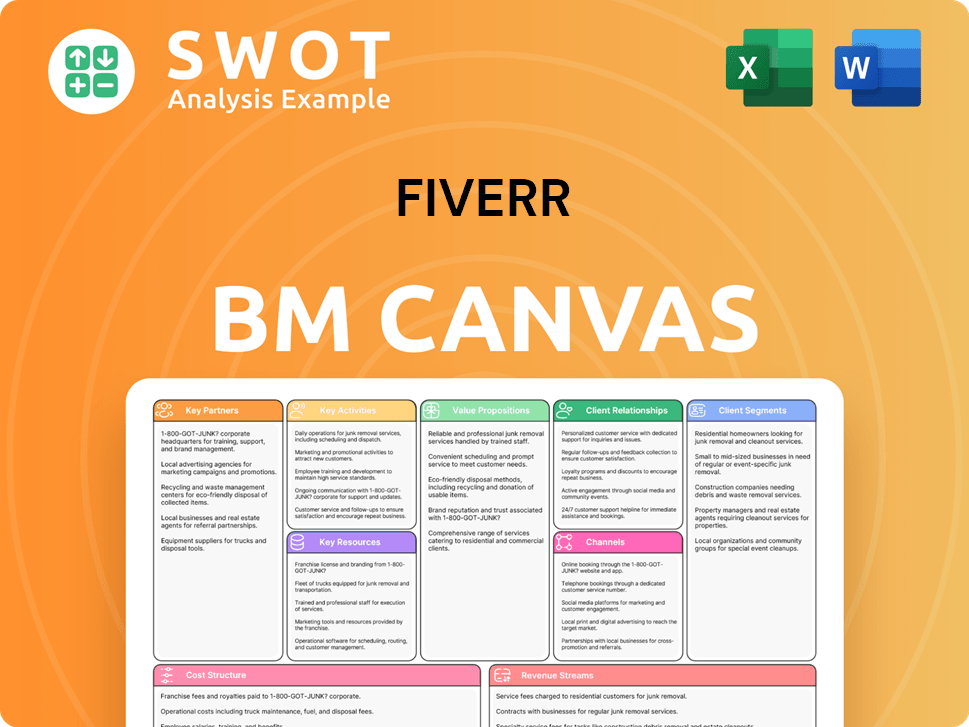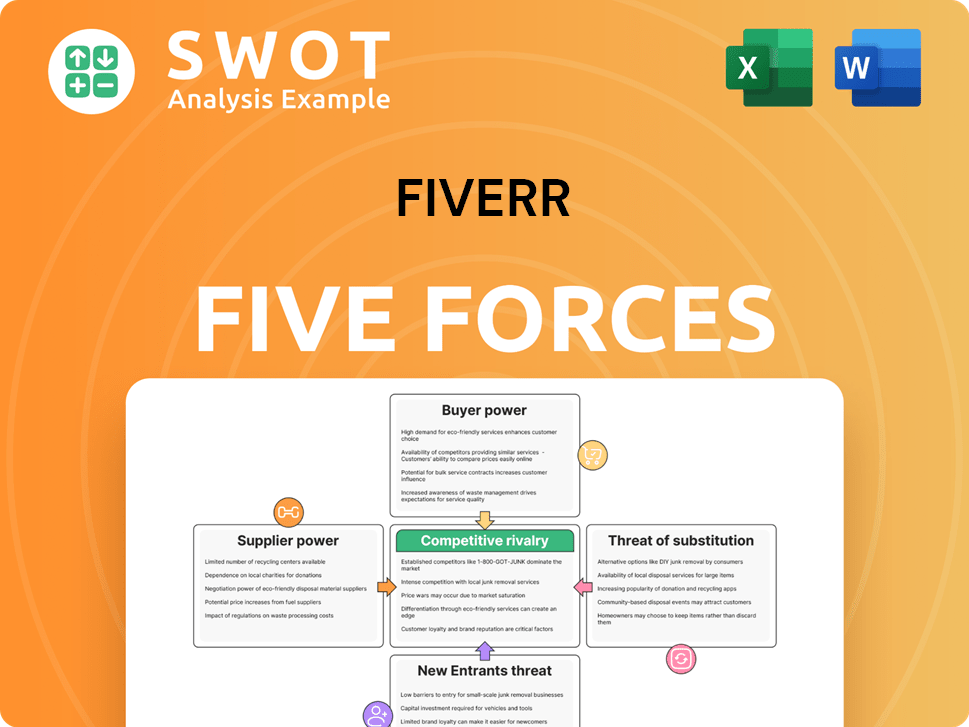Fiverr Bundle
How Did Fiverr Revolutionize the Freelance World?
Fiverr, a pioneering force in the gig economy, emerged with a deceptively simple premise: offer services, or 'gigs,' starting at just $5. Founded in 2010, this Fiverr SWOT Analysis reveals the company's strategic evolution. From its humble beginnings, Fiverr has transformed how businesses and freelancers connect globally, reshaping the landscape of online services.

This article delves into the Fiverr company origin story, exploring its pivotal moments and the evolution of its business model. We'll uncover when Fiverr was founded, examining its early growth and the innovative strategies that fueled its expansion from a $5 gig platform to a leading freelance marketplace. Discover how Fiverr's impact on the gig economy continues to evolve.
What is the Fiverr Founding Story?
The Fiverr company story began on February 1, 2010. Micha Kaufman and Shai Wininger launched the platform in Tel Aviv, Israel. They saw an opportunity in the growing demand for digital services and the rise of flexible work.
The founders aimed to create a marketplace for quick, affordable tasks. This was a new approach in the online services market. The initial concept centered around services, or 'gigs,' priced at a flat rate of $5. This model made the platform accessible and disruptive.
The original business model was simple. Freelancers offered services, and buyers purchased them for $5. Fiverr took a commission from each transaction. This 'gig economy' pioneer started with simple digital tasks. These included logo design, writing, and social media posts. The name 'Fiverr' reflected the $5 price point, symbolizing the platform's affordability and simplicity.
Fiverr's early days involved bootstrapping and seed rounds from private investors. These funds helped develop the platform and attract users. Kaufman's marketing background and Wininger's expertise in product development were crucial.
- Fiverr history began in 2010 with a focus on $5 gigs.
- The platform quickly gained traction in the freelance marketplace.
- The founders' complementary skills were key to its early success.
- Initial funding came from bootstrapping and private investors.
Fiverr SWOT Analysis
- Complete SWOT Breakdown
- Fully Customizable
- Editable in Excel & Word
- Professional Formatting
- Investor-Ready Format

What Drove the Early Growth of Fiverr?
The early growth of the Fiverr company was marked by rapid expansion, driven by the viral appeal of its $5 gig concept and the increasing demand for accessible freelance services. The platform focused on broadening its user base and diversifying service offerings beyond the original digital services. Early customer acquisition relied heavily on word-of-mouth and the inherent shareability of unique and affordable services. This period set the stage for Fiverr's transformation into a leading freelance marketplace.
Fiverr's early customer acquisition strategies were heavily reliant on word-of-mouth and the inherent shareability of its unique and affordable services. The platform's initial success was significantly boosted by the novelty of its $5 gig concept, which quickly went viral. This approach allowed Fiverr to attract users organically, creating a strong foundation for its early growth. The platform's ability to offer diverse services at a low cost attracted a wide range of users, contributing to its rapid expansion in the freelance marketplace.
In 2011, Fiverr introduced 'Gig Extras,' allowing freelancers to offer additional services at higher price points. This strategic shift was pivotal, transforming Fiverr from a novelty platform into a more comprehensive marketplace. This change increased the potential revenue for both freelancers and the platform. This move was crucial in shaping Fiverr's trajectory, moving it towards becoming a more professional and diverse freelance marketplace, and boosting its revenue model.
Fiverr expanded its service categories to include a wider range of digital services, such as programming, video editing, and voice-overs. This diversification broadened the platform's appeal to a larger audience. By offering a more comprehensive suite of services, Fiverr solidified its position in the freelance marketplace. This expansion was a key factor in its ability to attract both freelancers and clients.
The company secured significant capital raises, including a Series A round of $15 million in 2012, which fueled its expansion efforts. By 2013, Fiverr had surpassed 3 million gigs listed on its platform, demonstrating significant market penetration. The growth metrics continued to climb, with user growth rates soaring as more individuals and businesses discovered the platform's efficiency and affordability. For more details, check out the Growth Strategy of Fiverr.
Fiverr PESTLE Analysis
- Covers All 6 PESTLE Categories
- No Research Needed – Save Hours of Work
- Built by Experts, Trusted by Consultants
- Instant Download, Ready to Use
- 100% Editable, Fully Customizable

What are the key Milestones in Fiverr history?
The history of the Fiverr company is marked by significant milestones that have shaped its evolution within the freelance marketplace and the broader gig economy. From its inception, Fiverr has consistently adapted and innovated to meet the changing demands of both freelancers and businesses seeking online services.
| Year | Milestone |
|---|---|
| 2010 | Fiverr was founded, revolutionizing the freelance market with its initial $5 service model. |
| 2012 | Fiverr secured its first major funding round, fueling its early growth and expansion. |
| 2014 | Fiverr expanded its service offerings beyond the initial $5 model, increasing its flexibility. |
| 2017 | Fiverr launched Fiverr Pro, introducing a curated marketplace for high-quality, vetted freelancers. |
| 2019 | Fiverr acquired ClearVoice, enhancing its content marketing capabilities. |
| 2019 | Fiverr went public, marking a significant step in its corporate journey. |
| 2021 | Fiverr acquired Stoke, providing comprehensive freelance management solutions. |
Fiverr's innovations have been pivotal in transforming the landscape of online services. A key innovation was the introduction of Fiverr Pro, which catered to the demand for premium services and attracted larger businesses.
Fiverr expanded into new service categories, including data science, gaming, and e-commerce marketing. This diversification allowed the platform to cater to a broader range of client needs, driving growth.
The launch of Fiverr Pro was a significant innovation, offering a curated marketplace for vetted, high-quality freelancers. This move helped to attract larger businesses and projects, increasing the platform's average order value.
Fiverr consistently refined its platform to enhance user experience, making it more intuitive for both freelancers and clients. This included improvements in search functionality and communication tools.
Acquisitions like ClearVoice and Stoke expanded Fiverr's capabilities. These acquisitions allowed the platform to offer more comprehensive solutions to its users.
Improvements to the mobile app made it easier for freelancers and clients to manage projects on the go. This enhanced accessibility contributed to increased platform usage.
Fiverr introduced subscription models for certain services, providing clients with recurring access to freelancers. This fostered long-term relationships and predictable revenue streams.
Fiverr has faced challenges, particularly in its early years, related to perceptions of low-quality work. The company actively combatted this by implementing quality control measures and user reviews.
Fiverr faces competition from other freelance platforms, requiring constant innovation and strategic adjustments. Staying ahead in a competitive market is an ongoing challenge.
Maintaining the quality of services offered on the platform has been a continuous challenge. Implementing effective quality control measures is crucial for user satisfaction.
Economic downturns can impact the demand for freelance services. Fiverr needs to adapt to changing market conditions to maintain growth.
Attracting and retaining both freelancers and clients is a constant challenge. Fiverr must continually improve its platform and services to keep users engaged.
Expanding into new global markets presents logistical and cultural challenges. Adapting to local needs is essential for successful international growth.
Navigating the complexities of regulatory compliance in different regions is an ongoing challenge. Staying compliant with various laws is crucial for legal operation.
For a deeper dive into the competitive landscape, consider exploring the Competitors Landscape of Fiverr.
Fiverr Business Model Canvas
- Complete 9-Block Business Model Canvas
- Effortlessly Communicate Your Business Strategy
- Investor-Ready BMC Format
- 100% Editable and Customizable
- Clear and Structured Layout

What is the Timeline of Key Events for Fiverr?
The Fiverr company origin story began on February 1, 2010, in Tel Aviv, Israel, when Micha Kaufman and Shai Wininger founded the platform. The freelance marketplace quickly evolved, introducing 'Gig Extras' in 2011 and securing $15 million in Series A funding in 2012. By 2013, the platform had over 3 million gigs listed, and in 2015, Fiverr Anywhere expanded service offerings. The company launched Fiverr Pro in 2017 and went public on the New York Stock Exchange (NYSE) in June 2019. Acquisitions like ClearVoice in 2019 and Stoke in 2021 further solidified its position. Throughout the COVID-19 pandemic in 2020, Fiverr experienced substantial growth, and it continued expanding into new service categories and global markets in 2023.
| Year | Key Event |
|---|---|
| 2010 | Fiverr was founded in Tel Aviv, Israel, by Micha Kaufman and Shai Wininger. |
| 2011 | 'Gig Extras' were introduced, allowing freelancers to offer services beyond the $5 base price. |
| 2012 | Fiverr secured $15 million in Series A funding. |
| 2013 | The platform surpassed 3 million gigs listed. |
| 2015 | Fiverr Anywhere was launched, enabling custom services. |
| 2017 | 'Fiverr Pro' was introduced, featuring vetted, high-quality freelancers. |
| 2019 | Fiverr went public on the New York Stock Exchange (NYSE) and acquired ClearVoice. |
| 2020 | The company saw significant growth due to increased demand for online work. |
| 2021 | Fiverr acquired Stoke, a freelance management platform. |
| 2023 | Continued expansion into new service categories and global markets. |
Fiverr is focusing on integrating artificial intelligence and machine learning to enhance the matching process between clients and freelancers. This technology aims to improve efficiency and personalization on the platform. Recent developments in AI are expected to streamline service recommendations and project management.
The company is expanding its enterprise-level solutions to cater to larger businesses. This includes providing customized services, dedicated account management, and tools for managing freelance teams. These solutions are designed to streamline the process for businesses to access talent.
Fiverr plans to further penetrate existing markets and explore new geographical regions. This strategy involves tailoring services to meet local demands and expanding its global footprint. The focus remains on increasing the platform's reach and accessibility worldwide.
The global gig economy is projected to reach a market volume of over $450 billion by 2025. Fiverr is well-positioned to capitalize on this growth by continuing to empower freelancers and simplify access to talent for businesses. This expansion is expected to drive revenue growth.
Fiverr Porter's Five Forces Analysis
- Covers All 5 Competitive Forces in Detail
- Structured for Consultants, Students, and Founders
- 100% Editable in Microsoft Word & Excel
- Instant Digital Download – Use Immediately
- Compatible with Mac & PC – Fully Unlocked

Related Blogs
- What is Competitive Landscape of Fiverr Company?
- What is Growth Strategy and Future Prospects of Fiverr Company?
- How Does Fiverr Company Work?
- What is Sales and Marketing Strategy of Fiverr Company?
- What is Brief History of Fiverr Company?
- Who Owns Fiverr Company?
- What is Customer Demographics and Target Market of Fiverr Company?
Disclaimer
All information, articles, and product details provided on this website are for general informational and educational purposes only. We do not claim any ownership over, nor do we intend to infringe upon, any trademarks, copyrights, logos, brand names, or other intellectual property mentioned or depicted on this site. Such intellectual property remains the property of its respective owners, and any references here are made solely for identification or informational purposes, without implying any affiliation, endorsement, or partnership.
We make no representations or warranties, express or implied, regarding the accuracy, completeness, or suitability of any content or products presented. Nothing on this website should be construed as legal, tax, investment, financial, medical, or other professional advice. In addition, no part of this site—including articles or product references—constitutes a solicitation, recommendation, endorsement, advertisement, or offer to buy or sell any securities, franchises, or other financial instruments, particularly in jurisdictions where such activity would be unlawful.
All content is of a general nature and may not address the specific circumstances of any individual or entity. It is not a substitute for professional advice or services. Any actions you take based on the information provided here are strictly at your own risk. You accept full responsibility for any decisions or outcomes arising from your use of this website and agree to release us from any liability in connection with your use of, or reliance upon, the content or products found herein.